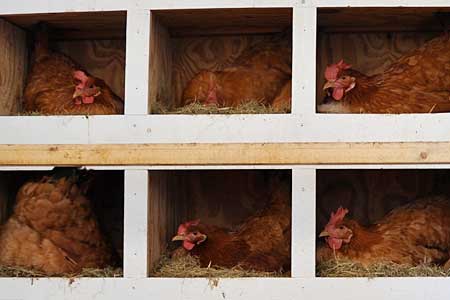
How many chicken nest boxes you need in your coop depends in part on the number of hens in your flock. A second factor is whether or not your hens one of the top laying breeds. Here are some guidelines for determining the best number of nests for your specific flock.
How Many Nests
The rule of thumb is to furnish one nest for every four to five hens in your flock. But if you have only four or five hens, providing two nests gives them a choice. It also helps prevent crowding when two hens want to lay at the same time.
Each hen generally chooses her favorite nest. So you’ll often see the same hen always laying in the same nest. If another hen beats her to it, she might try to crowd in. Or she might stand in front of the nest she wants and fuss at the hen that’s in it. Or she might move to another nest.
Having properly designed nests that are all alike helps reduce squabbles over which one is best, assuming you furnish enough of them. If, for example, you have six or eight hens, furnish at least two nests; three is better. For 10 to 12 hens, provide at least three.
Too Many Nests
Installing one nest for every hen in your flock is overkill. Even among the best layers, not all the hens are going to lay at the same time or even on the same day.
Too many nests take up unnecessary space. And they invite loitering in the nests instead of entering to lay and then leaving. Plus you’ll have more work cleaning out and replacing nesting material from unneeded nests.
Even when you determine how many chicken nest boxes you need given your flock size, hens might still pile into one nest to lay. If you add more nests, the hens may ignore the new ones, preferring to lay in the original nest.
Take a critical look to see if the nest they prefer is a different design, or is in a better position, than the others. Otherwise, maybe your hens are just especially social and like cozying up together.
Too Few Nests
When a coop has too few nests, a hen with an urgent need to lay an egg may not be willing to wait her turn. If she crowds into an occupied nest, eggs may get trampled and broken. And broken eggs lead to egg eating, a habit that’s hard to break.
Or, instead of crowding into a nest, sometimes a hen loses patience and lays her egg on the floor. Eggs laid on the floor might be hard to find. Sometimes they get broken. And most of the time they get dirty. These are good reasons for furnishing nests in the first place.
Even if you follow the guidelines of providing at least one nest per four or five hens, you might have too few if your hens are of the best layer breeds that lay eggs nearly every day. In that case, furnishing a few more than the standard number of nests per hen will reduce waiting time and conflicts.
And that’s today’s news from the Cackle Coop.
Gail Damerow is the author of Storey’s Guide to Raising Chickens.

